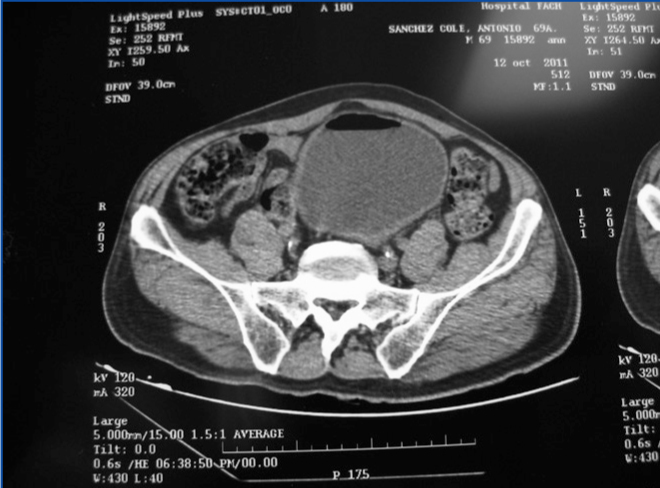To the Editor,
Emphysematous cystitis is a rare infectious complication mainly seen in diabetic patients.
Here, we present the first case of this disease examined by our Department. A 69 years old male patient with insulin-dependent diabetes and poor metabolic control was admitted due to an acute fever accompanied by nausea, vomiting and pneumaturia. The patient also had arterial hypertension, stent revascularisation for coronary heart disease, and had been diabetic for 20 years. He presented diabetic retinopathy, neuropathy and nephropathy. He had been monitored for obstructive uropathy secondary to adenoma of the prostate.
He was conscious and alert during the physical examination: arterial blood pressure 110/60; heart rate 80bpm; axillary temperature 38ºC; jugular veins flat. The rest of the examination was uneventful.
Laboratory testing delivered the following results: haemoglobin: 12g/dl; leukocytes: 6500; glycaemia: 738mg/dl; blood urea nitrogen: 68mg/dl; creatininaemia: 1.4mg/dl; [Na+] = 127mmol; [K+] = 5.4mmol; [Cl-] = 88mmol; [HCO3-] = 27mmol.
The urine test revealed leukocyturia, red blood cells >100 per field and abundant bacteria. The urine culture showed extended-spectrum beta lactamase-producing Escherichia coli.
The CT urography (a specific CT technique) showed air within the bladder lumen near its ventral face.
The patient received hydration, insulin therapy and treatment with ertapenem. Progress was excellent, with no septic shock and easy-to-manage hyperosmolar syndrome.
Emphysematous cystitis was discovered by Eisenlohr1 at the end of the 19th century and Bailey2 described this illness. It may present asymptomatically until the onset of severe sepsis, or it may pass through stages with pneumaturia and acute abdomen. For the case in question, the key symptom was pneumaturia and the presence of air in the bladder as shown by the CT (Figure 1).
In the series described by Thomas et al.3, the most common bacterial strain was E. coli, followed by Klebsiella. The mean age was 66 years, most affected individuals were women (64%) and most were diabetic (67%). The patient treated in our Department was similar in age to those in the other study, and also suffered diabetes with poor metabolic control. It has been postulated that air is produced by the fermentation of glucose in urine.4
Treatment is usually medical, as in our case, and the mortality rate is close to 7%. In isolated cases, treatment has been combined with surgery or a hyperbaric chamber.
Figure 1. CT Urography showing intravesical air








